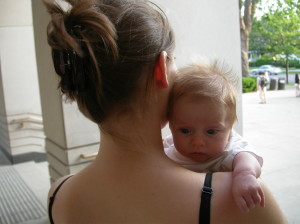by KERRY MAIORCA
Photos by Zach and Kerry Maiorca
On the other side of the intensely physical experience of labor and birth, the world after my first child’s arrival was a different place. Emails and news and mind stuff just faded away. My mom instincts were heightened and my world was my senses: the feel of a satiny smooth baby foot, the smell of my son’s sweaty head after he woke from a nap in the sling, the rhythms of his various breaths, my favorite being the in-in-out because it always made me think he was sighing.
To mother a new baby is to be an animal, a mama bear whose obsession is to fiercely protect an absurdly helpless being. When he was first born, I bumbled about trying to master the proper way to hold and support my son’s seemingly fragile body (oops, there goes that floppy baby head again). In doing so I often lived in complete disregard for my own physical state as I held a tortured position for hours because he had fallen asleep on me and I was afraid to move and possibly wake him.
As my son became a toddler and began moving independently of me, the physicality shifted. I became the chaser, the guardian, and my job was less about providing round-the-clock bodily contact and more about following this little independent being around to prevent mortal danger.
Now that my kids are 7 and 5 they no longer physically need me to carry, feed, and dress them, and they can manage their own bodies as they move through space. I simultaneously cherish my regained physical freedom while also feeling the echoes and ache of the prior all-consuming physicality. What was an obligation in those early days is a treat now that it’s not the norm. These days when my son or daughter are within cuddling range I hug and kiss them until they can’t stand it, knowing a rare opportunity when I see one.
The process of moving from the physicality of new parenthood to the shifting reality of parenting an older child is much like the process of becoming a more dedicated yoga student. You go from thinking it’s all about chaturanga and handstand to realizing that there’s so much more than just the physical. The practice takes a hold of you on a mental and emotional level, and that’s when things get really interesting.
After 18 years, my yoga practice has shifted from an intensely physical one to a more subtle exploration that weaves together meditation and mindful asana practice guided by the breath. But every time I come back to that familiar territory of unabashed physicality on the mat – whether via the burning of my thighs in a long hold in utkatasana, chair pose, or the incredibly enlivening opening of urdhva dhanurasana, full wheel – I appreciate it all the more because it’s not where I primarily live in my practice these days. It’s like paging back though the old yoga baby book to see how far I’ve come, to reconnect with that younger, mushier version of my practitioner self.
When I see a new mom and baby cuddled up together I still have visceral memories of those early days of holding, nursing, changing, rocking. When I held my son, our breaths would sync. If I moved, he would stir. At the end of a long day of mothering when he was finally out of my arms, I’d need a mom-savasana to clean the slate and withdraw from my overloaded senses.
I was just there. Only yesterday my arms ached from the holding and bouncing and soothing as this small being shrieked in my ear. Looking at mother and baby now, I smile the slightly longing, slightly relieved smile of a mama bear that can no longer lumber around with young attached but carries the memories of that early tenderness and physicality and exhaustion as a memento, an imprint.
I hope I never forget how that time of early motherhood felt in my body. And I hope I never lose appreciation for how wonderful it feels to be here now.


























No Responses to “The Householder Yogi: The Physicality of Newness”